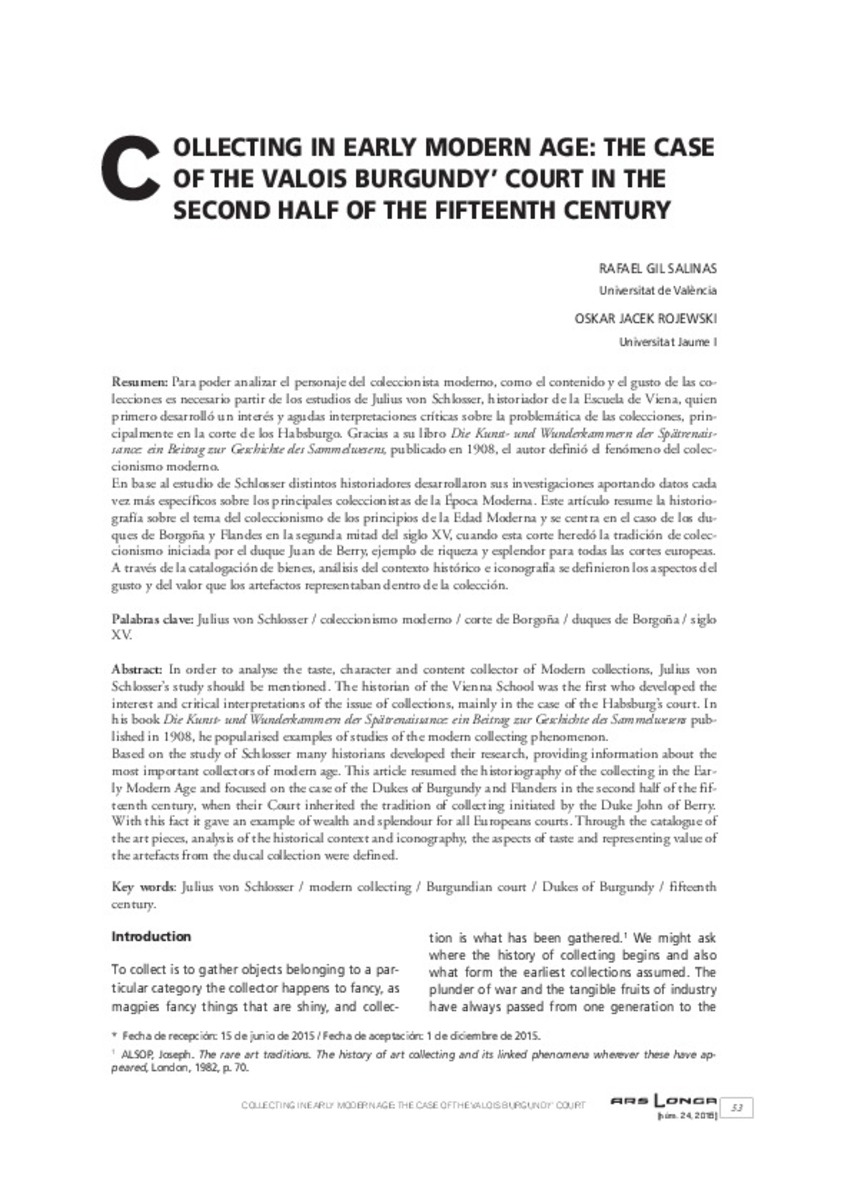Mostrar el registro sencillo del ítem
Collecting in early modern age: The case of the of the Valois Burgundy' Court in the second half of the fifteenth century
| dc.contributor.author | Gil Salinas, Rafael | |
| dc.contributor.author | Rojewski, Oskar Jacek | |
| dc.date.accessioned | 2016-10-20T09:43:20Z | |
| dc.date.available | 2016-10-20T09:43:20Z | |
| dc.date.issued | 2015 | |
| dc.identifier.citation | GIL SALINAS, Rafael; ROJEWSKI, Oskar Jacek. Collecting in Early Modern Age: the case of the Valois Burgundy Court in the second half of the fifteen century. Ars Longa (2015), n. 24, pp. 53-70 | ca_CA |
| dc.identifier.uri | http://hdl.handle.net/10234/163731 | |
| dc.description.abstract | In order to analyse the taste, character and content collector of Modern collections, Julius von Schlosser’s study should be mentioned. The historian of the Vienna School was the first who developed the interest and critical interpretations of the issue of collections, mainly in the case of the Habsburg’s court. In his book Die Kunst- undWunderkammern der Spätrenaissance: ein Beitrag zur Geschichte des Sammelwesens published in 1908, he popularised examples of studies of the modern collecting phenomenon. Based on the study of Schlosser many historians developed their research, providing information about the most important collectors of modern age. This article resumed the historiography of the collecting in the Early Modern Age and focused on the case of the Dukes of Burgundy and Flanders in the second half of the fifteenth century, when their Court inherited the tradition of collecting initiated by the Duke John of Berry. With this fact it gave an example of wealth and splendour for all Europeans courts. Through the catalogue of the art pieces, analysis of the historical context and iconography, the aspects of taste and representing value of the artefacts from the ducal collection were defined. | ca_CA |
| dc.description.abstract | Para poder analizar el personaje del coleccionista moderno, como el contenido y el gusto de las colecciones es necesario partir de los estudios de Julius von Schlosser, historiador de la Escuela de Viena, quien primero desarrolló un interés y agudas interpretaciones críticas sobre la problemática de las colecciones, principalmente en la corte de los Habsburgo. Gracias a su libro Die Kunst- und Wunderkammern der Spätrenaissance: ein Beitrag zur Geschichte des Sammelwesens, publicado en 1908, el autor definió el fenómeno del coleccionismo moderno. En base al estudio de Schlosser distintos historiadores desarrollaron sus investigaciones aportando datos cada vez más específicos sobre los principales coleccionistas de la Época Moderna. Este artículo resume la historiografía sobre el tema del coleccionismo de los principios de la Edad Moderna y se centra en el caso de los duques de Borgoña y Flandes en la segunda mitad del siglo XV, cuando esta corte heredó la tradición de coleccionismo iniciada por el duque Juan de Berry, ejemplo de riqueza y esplendor para todas las cortes europeas. A través de la catalogación de bienes, análisis del contexto histórico e iconografía se definieron los aspectos del gusto y del valor que los artefactos representaban dentro de la colección. | ca_CA |
| dc.format.extent | 18 p. | ca_CA |
| dc.format.mimetype | application/pdf | ca_CA |
| dc.language.iso | eng | ca_CA |
| dc.publisher | Universitat de València. Departament d'Història de l'Art | ca_CA |
| dc.relation.isPartOf | Ars Longa (2015), n. 24 | ca_CA |
| dc.rights.uri | http://rightsstatements.org/vocab/CNE/1.0/ | * |
| dc.subject | Julius von Schlosser | ca_CA |
| dc.subject | Modern collecting | ca_CA |
| dc.subject | Burgundian court | ca_CA |
| dc.subject | Dukes of Burgundy | ca_CA |
| dc.subject | Fifteenth century. | ca_CA |
| dc.subject | Coleccionismo moderno | ca_CA |
| dc.subject | Corte de Borgoña | ca_CA |
| dc.subject | Duques de Borgoña | ca_CA |
| dc.subject | Siglo XV | ca_CA |
| dc.title | Collecting in early modern age: The case of the of the Valois Burgundy' Court in the second half of the fifteenth century | ca_CA |
| dc.type | info:eu-repo/semantics/article | ca_CA |
| dc.rights.accessRights | info:eu-repo/semantics/openAccess | ca_CA |
| dc.relation.publisherVersion | https://roderic.uv.es:8443/handle/10550/55082 | ca_CA |
| dc.type.version | info:eu-repo/semantics/publishedVersion |
Ficheros en el ítem
Este ítem aparece en la(s) siguiente(s) colección(ones)
-
HIS_Articles [432]
Articles de publicacions periòdiques







